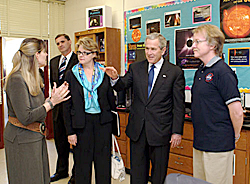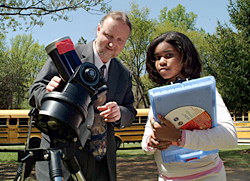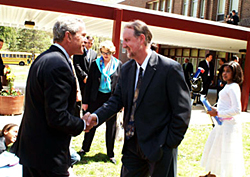- NASA Home
- | For Educators
- | Grades K-4
- | Featured Materials
Feature
Praised by the President
10.24.06
| Who are NASA's Space Science Explorers? The scientist studying black holes in distant galaxies. And the engineer designing robotic instruments for probing hard-to-reach planets. But also the teacher explaining the mysteries of the cosmos. And the elementary schooler wondering if life exists anywhere besides Earth. All of these people are Space Science Explorers -- they are all connected by their quest to explore and understand our solar system and universe. This monthly series will introduce you to NASA Space Science Explorers, young and old, with a variety of backgrounds and interests. Nominate a Space Science Explorer! Tell us about the Space Science Explorers you know. We're looking for students, teachers, scientists and others who have a connection to NASA, whether they work for the agency or are involved in a NASA-supported mission or program. Send your nominations to Dan Stillman: dan_stillman@strategies.org. |
NASA astronomers Sten Odenwald and Lou Mayo were recently praised by President Bush for their efforts to teach young people about space science.
"These are good, hardworking folks who said, 'I kind of want to lend my expertise to try to convince a child that science is cool,'" said the president as he spoke at a Maryland middle school about the importance of science, technology, engineering and mathematics education. "Science is not only cool -- it's really important for the future of this country."
How did Odenwald and Mayo attract the attention of the president? Space Science Explorers set out to learn more about what these two scientists do, and how they became interested in space.
Sten Odenwald
Though afraid of the dark, both as a youngster and even now as an adult, Odenwald has always been fascinated by the night sky.

|
Image to left: Sten Odenwald (far right) and astronomy teacher Dorian Janney (far left) meet with President Bush and U.S. Secretary of Education Margaret Spellings. School principal Kevin Hobbs looks on in the background. Credit: NASA
Odenwald's passion for stars and space started long before the first space shuttle took flight, before a spacecraft first landed on Mars, and before a human being first set foot on the moon.
Growing up, Odenwald collected pictures of faraway galaxies the way some kids collect baseball cards. Instead of obsessing over batting averages and pitching stats, he memorized the distances to galaxies and the names of constellations.
By fifth grade, Odenwald had his first telescope, and as a sixth-grader in 1964, he wrote a letter to NASA expressing his interest in astronomy and space science. In return, he says he received "a huge envelope bursting with booklets and mission foldouts."
That response was all the encouragement Odenwald needed to become officially hooked on space. Since then, he has dedicated his life to studying the solar system and universe, and to teaching others what he has learned.
|
Related Resources + Previous Space Science Explorers articles + NASA Space Weather Action Center + NASA IMAGE Science Center |
In his role as education and public outreach manager for IMAGE, a NASA satellite mission to study Earth's magnetosphere, Odenwald helped develop educational materials for teachers and students. He also helped NASA to publicize the 2004 transit of Venus -- the rare passing of Venus between the Earth and sun.
Sometimes the most effective way to educate is in person. Odenwald makes weekly visits to the Parkland Magnet Middle School for Aerospace Technology in Rockville, Md. He teaches students about astronomy and space, and explains the physics of pressure and sound.
This past school year, Odenwald led a lunchtime science program at Parkland. In the program, 15 students used star data to determine where the edge of the Milky Way galaxy is located. The students presented their work to President Bush during his recent visit to the school.
By working closely with young people, Odenwald hopes to inspire a new generation of scientists to follow in his footsteps.
"As an astronomer, some of the brightest stars I discover are in the classroom," Odenwald said.
Lou Mayo
For Lou Mayo, birthdays have never been the only reason to have a party.
By second grade, the young sky watcher was having classmates over for "star parties" in his backyard. Taking a break from running around and yelling, Mayo and his friends would stop to look at the stars though his shiny new telescope.

|
Image to left: Lou Mayo uses telescopes to spark student interest in astronomy. Credit: NASA
The work Mayo does as an adult is complex. But he still has the simple curiosity for the night sky that he had as a kid. To nurture a similar interest in up-and-coming scientists, Mayo takes part in various educational activities aimed at students and teachers.
"I want to help kids experience the same sense of wonder and excitement about the possibilities of space as I did," Mayo said.
Mayo created and runs a NASA-sponsored network of after-school astronomy clubs. These clubs are scattered around the world and engage K-12 students in activities -- such as star parties and field trips to planetariums -- that are often beyond the scope of traditional classroom instruction.

|
Image to right: Lou Mayo shakes hands with President Bush, as U.S. Secretary of Education Margaret Spellings interacts with students outside the school. Credit: NASA
One goal Mayo has is to clear up misconceptions people may have about space. For example, he says, some students (and even teachers) wrongly believe that the North Star is the brightest star in the sky, or that Jupiter has a solid surface. The brightest star is actually Sirius, also known as the "Dog Star," and Jupiter's surface is made of colorful clouds of gas.
For every question Mayo answers, or every myth he debunks, there are hundreds of other mysterious objects and phenomena in the solar system and beyond to learn about. According to Mayo, the seemingly endless possibilities of space are a good thing for young people.
"I think space is a natural hook for kids. It's permission for them to think big and wonder about things that are too weird, too scary, or too big to get their minds around," Mayo said.